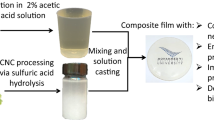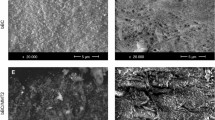Abstract
The solution casting method was used to prepare N-succinyl chitosan/cellulose acetate (NSCCA)-based bionanocomposite films. Bentonite (BN) was added as a nanofiller to the solution mixture (NSC/CA) and chitosan (CS) was used as a control. The NSCCA-based bionanocomposite films were characterized using various techniques such as Fourier transform infrared (FTIR) spectroscopy, scanning electron microscopy, X-ray diffraction (XRD), Thermogravimetric Analysis, water contact angle (WCA), water vapor transmission rate (WVTR), moisture content (MC), water solubility (WS), opacity, and tensile strength (TS). FTIR and XRD results confirmed the interaction between bentonite, chitosan, and N-succinyl chitosan (NSC). With the incorporation of CA and BN into the CS-NSC matrix, the MC, WS, WAC, and WVTR values decreased, whereas the opacity value (7.74 ± 0.32) of the bionanocomposite film increased significantly compared to pure CS film (2.12 ± 0.62). These findings suggested that the prepared bionanocomposites films could be effectively used for food packaging applications.
Graphical abstract









Similar content being viewed by others
References
R.M. Abdel-Rahman, A.M. Abdel-Mohsen, R. Hrdina, L. Burgert, Z. Fohlerova, D. Pavliňák, O.N. Sayed, J. Jancar, Wound dressing based on chitosan/hyaluronan/nonwoven fabrics: preparation, characterization and medical applications. Int. J. Biol. Macromol. 89, 725–736 (2016). https://doi.org/10.1016/J.IJBIOMAC.2016.04.087
A.S. Montaser, A.M. Abdel-Mohsen, M.A. Ramadan, A.A. Sleem, N.M. Sahffie, J. Jancar, A. Hebeish, Preparation and characterization of alginate/silver/nicotinamide nanocomposites for treating diabetic wounds. Int. J. Biol. Macromol. 92, 739–747 (2016). https://doi.org/10.1016/J.IJBIOMAC.2016.07.050
S.M. Costa, D.P. Ferreira, P. Teixeira, L.F. Ballesteros, J.A. Teixeira, R. Fangueiro, Active natural-based films for food packaging applications: the combined effect of chitosan and nanocellulose. Int. J. Biol. Macromol. 177, 241–251 (2021). https://doi.org/10.1016/j.ijbiomac.2021.02.105
M. Salari, M. SowtiKhiabani, R. RezaeiMokarram, B. Ghanbarzadeh, H. SamadiKafil, Development and evaluation of chitosan based active nanocomposite films containing bacterial cellulose nanocrystals and silver nanoparticles. Food Hydrocoll. 84, 414–423 (2018). https://doi.org/10.1016/j.foodhyd.2018.05.037
L. Rui, M. Xie, B. Hu, L. Zhou, D. Yin, X. Zeng, A comparative study on chitosan/gelatin composite films with conjugated or incorporated gallic acid. Carbohydr. Polym. 173, 473–481 (2017). https://doi.org/10.1016/J.CARBPOL.2017.05.072
N. Naseri, A.P. Mathew, L. Girandon, M. Fröhlich, K. Oksman, Porous electrospun nanocomposite mats based on chitosan–cellulose nanocrystals for wound dressing: effect of surface characteristics of nanocrystals. Cellulose 22, 521–534 (2014). https://doi.org/10.1007/S10570-014-0493-Y
N. Devi, J. Dutta, Preparation and characterization of chitosan-bentonite nanocomposite films for wound healing application. Int. J. Biol. Macromol. 104, 1897–1904 (2017). https://doi.org/10.1016/j.ijbiomac.2017.02.080
H. Sashiwa, N. Yamamori, Y. Ichinose, J. Sunamoto, S. Aiba, Chemical modification of chitosan, 17. Macromol. Biosci. 3, 231–233 (2003). https://doi.org/10.1002/MABI.200390029
S. Bautista-Baños, G. Romanazzi, A. Jiménez-Aparicio, Chitosan in the Preservation of Agricultural Commodities (Academic Press, Cambridge, 2016)
X. Qing, G. He, Z. Liu, Y. Yin, W. Cai, L. Fan, P. Fardim, Preparation and properties of polyvinyl alcohol/N–succinyl chitosan/lincomycin composite antibacterial hydrogels for wound dressing. Carbohydr. Polym. 261, 117875 (2021). https://doi.org/10.1016/j.carbpol.2021.117875
A. Rajeswari, E.J.S. Christy, E. Swathi, A. Pius, Fabrication of improved cellulose acetate-based biodegradable films for food packaging applications. Environ. Chem. Ecotoxicol. 2, 107–114 (2020). https://doi.org/10.1016/j.enceco.2020.07.003
J.A. Ramírez, C.J. Suriano, P. Cerrutti, M.L. Foresti, Surface esterification of cellulose nanofibers by a simple organocatalytic methodology. Carbohydr. Polym. 114, 416–423 (2014). https://doi.org/10.1016/J.CARBPOL.2014.08.020
M. Koosha, S. Hamedi, Intelligent Chitosan/PVA nanocomposite films containing black carrot anthocyanin and bentonite nanoclays with improved mechanical, thermal and antibacterial properties. Prog. Org. Coat. 127, 338–347 (2019). https://doi.org/10.1016/j.porgcoat.2018.11.028
H.A. El-Rehim, H. Kamal, E.S.A. Hegazy, E.S. Soliman, A. Sayed, Use of gamma rays to improve the mechanical and barrier properties of biodegradable cellulose acetate nanocomposite films. Radiat. Phys. Chem. 153, 180–187 (2018). https://doi.org/10.1016/j.radphyschem.2018.08.007
A. Khan, R.A. Khan, S. Salmieri, C. Le Tien, B. Riedl, J. Bouchard, G. Chauve, V. Tan, M.R. Kamal, M. Lacroix, Mechanical and barrier properties of nanocrystalline cellulose reinforced chitosan based nanocomposite films. Carbohydr. Polym. 90, 1601–1608 (2012). https://doi.org/10.1016/j.carbpol.2012.07.037
M.P. Indumathi, K. SaralSarojini, G.R. Rajarajeswari, Antimicrobial and biodegradable chitosan/cellulose acetate phthalate/ZnO nano composite films with optimal oxygen permeability and hydrophobicity for extending the shelf life of black grape fruits. Int. J. Biol. Macromol. 132, 1112–1120 (2019). https://doi.org/10.1016/j.ijbiomac.2019.03.171
N. Devi, J. Dutta, Development and in vitro characterization of chitosan/starch/halloysite nanotubes ternary nanocomposite films. Int. J. Biol. Macromol. 127, 222–231 (2019). https://doi.org/10.1016/j.ijbiomac.2019.01.047
A.M. Ahmad, Potential pharmacokinetic interactions between antiretrovirals and medicinal plants used as complementary and African traditional medicines. Biopharm. Drug Dispos. 28, 135–143 (2007). https://doi.org/10.1002/bdd
X. Niu, L. Zhu, L. Xi, L. Guo, H. Wang, An antimicrobial agent prepared by N-succinyl chitosan immobilized lysozyme and its application in strawberry preservation. Food Control 108, 106829 (2020). https://doi.org/10.1016/j.foodcont.2019.106829
S. Bashir, Y.Y. Teo, S. Ramesh, K. Ramesh, M.W. Mushtaq, Rheological behavior of biodegradable N-succinyl chitosan-g-poly (acrylic acid) hydrogels and their applications as drug carrier and in vitro theophylline release. Int. J. Biol. Macromol. 117, 454–466 (2018). https://doi.org/10.1016/j.ijbiomac.2018.05.182
J. Dutta, N. Devi, Preparation, optimization, and characterization of chitosan-sepiolite nanocomposite films for wound healing. Int. J. Biol. Macromol. 186, 244–254 (2021). https://doi.org/10.1016/j.ijbiomac.2021.07.020
P. Fei, L. Liao, B. Cheng, J. Song, Quantitative analysis of cellulose acetate with a high degree of substitution by FTIR and its application. Anal. Methods 9, 6194–6201 (2017). https://doi.org/10.1039/c7ay02165h
H. Zhou, H. Tong, J. Lu, Y. Cheng, F. Qian, Y. Tao, H. Wang, Preparation of bio-based cellulose acetate/chitosan composite film with oxygen and water resistant properties. Carbohydr. Polym. 270, 118381 (2021). https://doi.org/10.1016/j.carbpol.2021.118381
S. Wan, Y. Sun, X. Qi, F. Tan, Improved bioavailability of poorly water-soluble drug curcumin in cellulose acetate solid dispersion. AAPS PharmSciTech 13, 159–166 (2012). https://doi.org/10.1208/s12249-011-9732-9
O.V. Alekseeva, A.N. Rodionova, N.A. Bagrovskaya, A.V. Agafonov, A.V. Noskov, Effect of the bentonite filler on structure and properties of composites based on hydroxyethyl cellulose. Arab. J. Chem. 12, 398–404 (2019). https://doi.org/10.1016/j.arabjc.2015.07.011
G. Hao, Y. Hu, L. Shi, J. Chen, A. Cui, W. Weng, K. Osako, Physicochemical characteristics of chitosan from swimming crab (Portunus trituberculatus) shells prepared by subcritical water pretreatment. Sci. Rep. 11, 1–9 (2021). https://doi.org/10.1038/s41598-021-81318-0
M. Yadav, K. Behera, Y.H. Chang, F.C. Chiu, Cellulose nanocrystal reinforced chitosan based UV barrier composite films for sustainable packaging. Polymers (Basel) 12, 202 (2020). https://doi.org/10.3390/polym12010202
D. Kim, K. Jeon, Y. Lee, J. Seo, K. Seo, H. Han, S. Khan, Preparation and characterization of UV-cured polyurethane acrylate/ZnO nanocomposite films based on surface modified ZnO. Prog. Org. Coat. 74, 435–442 (2012). https://doi.org/10.1016/J.PORGCOAT.2012.01.007
A.S. Kritchenkov, A.R. Egorov, O.V. Volkova, L.A. Zabodalova, E.P. Suchkova, N.Z. Yagafarov, M.N. Kurasova, A.P. Dysin, A.V. Kurliuk, T.V. Shakola, V.N. Khrustalev, Active antibacterial food coatings based on blends of succinyl chitosan and triazole betaine chitosan derivatives. Food Package Shelf Life 25, 100534 (2020). https://doi.org/10.1016/j.fpsl.2020.100534
B. Soni, E.B. Hassan, M.W. Schilling, B. Mahmoud, Transparent bionanocomposite films based on chitosan and TEMPO-oxidized cellulose nanofibers with enhanced mechanical and barrier properties. Carbohydr. Polym. 151, 779–789 (2016). https://doi.org/10.1016/j.carbpol.2016.06.022
A. Jayakumar, K.V. Heera, T.S. Sumi, M. Joseph, S. Mathew, G. Praveen, I.C. Nair, E.K. Radhakrishnan, Starch-PVA composite films with zinc-oxide nanoparticles and phytochemicals as intelligent pH sensing wraps for food packaging application. Int. J. Biol. Macromol. 136, 395–403 (2019). https://doi.org/10.1016/j.ijbiomac.2019.06.018
H. Mao, C. Wei, Y. Gong, S. Wang, W. Ding, Mechanical and water-resistant properties of eco-friendly chitosan membrane reinforced with cellulose nanocrystals. Polymers (Basel) 11, 166 (2019). https://doi.org/10.3390/polym11010166
M.H. Salehudin, E. Salleh, S.N.H. Mamat, I.I. Muhamad, Starch based active packaging film reinforced with empty fruit bunch (EFB) cellulose nanofiber. Procedia Chem. 9, 23–33 (2014). https://doi.org/10.1016/j.proche.2014.05.004
S. Ediyilyam, B. George, S.S. Shankar, T.T. Dennis, S. Wacławek, M. Černík, V.V. Padil, Chitosan / gelatin / silver nanoparticles composites films for biodegradable food packaging applications. Let us know how access to this document benefits you. Polymers (Basel) 13, 18 (2021)
L. Bastarrachea, S. Dhawan, S.S. Sablani, Engineering properties of polymeric-based antimicrobial films for food packaging. Food Eng. Rev. 3, 79–93 (2011). https://doi.org/10.1007/s12393-011-9034-8
M. Avella, J.J. De Vlieger, M.E. Errico, S. Fischer, P. Vacca, M.G. Volpe, Biodegradable starch/clay nanocomposite films for food packaging applications. Food Chem. 93, 467–474 (2005). https://doi.org/10.1016/J.FOODCHEM.2004.10.024
A. Yabannavar, R. Bartha, Biodegradability of some food packaging materials in soil. Soil Biol. Biochem. 25, 1469–1475 (1993). https://doi.org/10.1016/0038-0717(93)90001-R
C. Catarci-Carteny, R. Blust, Not only diamonds are forever: degradation of plastic films in a simulated marine environment. Front. Environ. Sci. 9, 1–11 (2021). https://doi.org/10.3389/fenvs.2021.662844
D. Hu, H. Wang, L. Wang, LWT Food Sci. Technol. (2015). https://doi.org/10.1016/j.lwt.2015.08.033
S.M. Gonçalves, J. Fagundes, G. Motta, R.S. Ribeiro, D. William, H. Chávez, N.R. De Melo, Functional and antimicrobial properties of cellulose acetate films incorporated with sweet fennel essential oil and plasticizers. Curr. Res. Food Sci. (2020). https://doi.org/10.1016/j.crfs.2020.01.001
M. Ghasemlou, F. Khodaiyan, A. Oromiehie, M.S. Yarmand, Development and characterisation of a new biodegradable edible film made from kefiran, an exopolysaccharide obtained from kefir grains. Food Chem. 127, 1496–1502 (2011). https://doi.org/10.1016/j.foodchem.2011.02.003
P. Wu, A.C. Fisher, P.P. Foo, D. Queen, J.D.S. Gaylor, In vitro assessment of water vapour transmission of synthetic wound dressings. Biomaterials 16, 171–175 (1995). https://doi.org/10.1016/0142-9612(95)92114-L
S.M. Ojagh, M. Rezaei, S.H. Razavi, S.M.H. Hosseini, Development and evaluation of a novel biodegradable film made from chitosan and cinnamon essential oil with low affinity toward water. Food Chem. 122, 161–166 (2010). https://doi.org/10.1016/J.FOODCHEM.2010.02.033
M. Kaya, S. Khadem, Y.S. Cakmak, M. Mujtaba, S. Ilk, L. Akyuz, A.M. Salaberria, J. Labidi, A.H. Abdulqadir, E. Deligöz, Antioxidative and antimicrobial edible chitosan films blended with stem, leaf and seed extracts of Pistacia terebinthus for active food packaging. RSC Adv. 8, 3941–3950 (2018). https://doi.org/10.1039/c7ra12070b
H.C. Oyeoka, C.M. Ewulonu, I.C. Nwuzor, C.M. Obele, J.T. Nwabanne, Packaging and degradability properties of polyvinyl alcohol/gelatin nanocomposite films filled water hyacinth cellulose nanocrystals. J. Bioresour. Bioprod. 6, 168–185 (2021). https://doi.org/10.1016/j.jobab.2021.02.009
Author information
Authors and Affiliations
Corresponding author
Additional information
Publisher's Note
Springer Nature remains neutral with regard to jurisdictional claims in published maps and institutional affiliations.
Supplementary Information
Below is the link to the electronic supplementary material.
Rights and permissions
Springer Nature or its licensor (e.g. a society or other partner) holds exclusive rights to this article under a publishing agreement with the author(s) or other rightsholder(s); author self-archiving of the accepted manuscript version of this article is solely governed by the terms of such publishing agreement and applicable law.
About this article
Cite this article
Priyanka, Thakur, R. & Dutta, J. N-succinyl chitosan-cellulose acetate-based bionanocomposite films: Preparation and characterization. Journal of Materials Research 38, 2738–2751 (2023). https://doi.org/10.1557/s43578-023-00999-7
Received:
Accepted:
Published:
Issue Date:
DOI: https://doi.org/10.1557/s43578-023-00999-7




